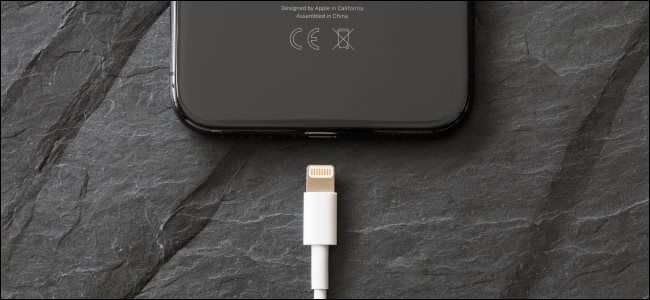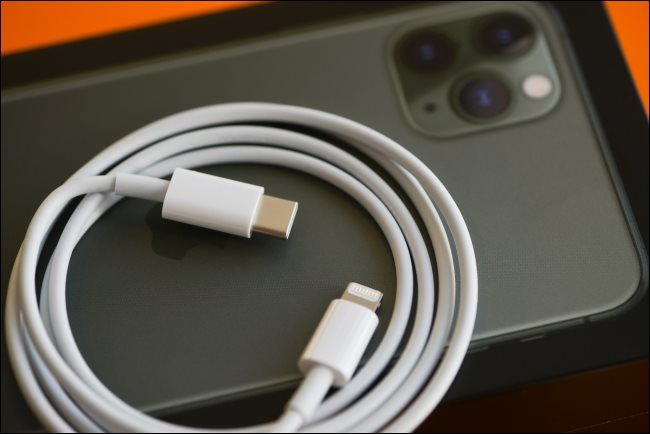Quick Links
Earlier this year, after an almost decade-long period of anguish, the European Parliament approved binding plans for a Europe-wide charging standard. But what does this actually mean? Well, it's complicated---but it could have effects far beyond Europe.
What Is the EU Doing?
The reporting on this subject has been confusing. For example, an article on The Verge originally argued the EU wasn't targeting Apple's Lightning connector, but simply wanted to require USB-C wall chargers---a product Apple already makes. The Verge later updated that article to clarify the situation wasn't so cut and dried.
We don't know yet exactly what the EU will require. It's possible it will demand that Apple replace the Lightning connector on iPhones sold in the EU with USB-C. Apple is certainly concerned about that possibility.
What we do know is the proposal, which passed with overwhelming support, will eventually mandate that all devices sold within the 27-member EU bloc use the same charging technology. When this is implemented, it will have ramifications for everyone, though, not just those who live in one of the 27 EU countries. We'll explain why.
Of Cables and Commissions
Before we can get into the meat of the plans, some background regarding what led to the European Commission’s latest proposals is necessary.
This isn’t the first time the EU has had mobile charging technology in its crosshairs. It's been a persistent pet peeve for the European Commission, which has been calling for a common standard across the bloc for the last decade
The issue first raised its thorny head in 2011, when feature (or "dumb") phones were still part of the mobile landscape. Back then, it wasn’t uncommon for manufacturers to use their proprietary chargers in their handsets, which were mutually incompatible.
A charger from Sony Ericsson, for example, didn’t work with a Nokia phone. Likewise, a plug from Alcatel didn’t work with a phone from Samsung.
There were a few problems with this. First, it was inconvenient for consumers, who (at one point) had to contend with 30 different charging standards. Second, it produced a tremendous amount of waste. Whenever you switched phones, your old charger became obsolete and almost certainly ended up in a landfill.
The rapid emergence of ubiquitous smartphones solved this problem They largely displaced feature phones for ordinary consumers, and coalesced around the micro USB standard. By 2013, 90 percent of all phone vendors had switched to micro USB.
The only outlier was, of course, Apple, which has always preferred using in-house standards. iPhones and other assorted devices previously used the 30-pin format before Apple switched to the smaller Lightning port in 2012.
In 2018, former European Commissioner for Competition, Margrethe Vestager, launched a study on the state of charging standards to produce concrete, Europe-wide rules.
So, what prompted the commission to revisit the issue?
Well, some devices still cling to the aging micro USB standard, while others are adopting USB-C. And yes, Lightning is still very much a thing on Apple devices.
Meanwhile, within the USB-C sphere, there’s an often-unseen amount of variation. Some phones support fast-charging, while others don’t. Some cables support USB-C PD, while others don’t. And, for that matter, is it USB-C or Thunderbolt?
What the EU Hopes to Accomplish
The European Parliament ordered the executive element of the bloc’s government, the European Commission, to take action on this issue by July 2020. It already has the power to accomplish this thanks to the Radio Equipment Directive, which was passed in 2014.
If the European Commission fails to reach a solid plan, Parliament has ordered the commission to craft a bespoke piece of legislation, which it will then vote on.
The proposals from the European Parliament don’t mandate or condemn any particular piece of technology, nor does it explicitly endorse USB-C or Lightning. However, given USB-C is the current power and data transfer standard used by many manufacturers, it’s pretty apparent where the chips will fall.
Of course, the common charging standard is likely to change over the years. Parliament explicitly called for measures that would allow regular reviews of the rules to ensure the EU keeps up with technology.
The EU will also introduce measures to ensure the interoperability of wireless charging systems in the years to come. This motion doesn’t address any real existing problems---wireless charging has become more standardized over time---but, rather, it's a protective mechanism for the future. The European Parliament is concerned about a potential future schism.
The prospect of phone manufacturers "unbundling" chargers and cables from their devices is another issue the EU wants to examine. The intention is to reduce the amount of electronic waste produced by the mobile industry. If you’ve already got a phone with a working charger, you don’t necessarily need another.
The proposal also considers the end of the charging life-cycle and wants to make it easier for people to recycle their busted or obsolete cables and plugs.
What Does This Mean for the Rest of the World?
EU legislation is only binding to its member nations and associated European Economic Area countries. However, as a bloc, the EU is sufficiently wealthy and large enough to influence countries far beyond its borders. It contains some of the world’s most important markets for consumer tech, including France, Germany, Spain, and Italy.
In most cases, it will make sense for phone manufacturers to conform to the EU’s as-yet-unpublished standard so they can sell their products worldwide---even in markets that don’t mandate it.
However, it’s also possible manufacturers will follow precedent and create EU-specific versions of their phones. Apple has produced a dual-sim version of the iPhone in China and Hong Kong for several years. Samsung has also provided more esoteric devices, like the Galaxy J2 DTV, to Asian markets.
Only time will tell, but these proposals might be slightly moot. Although USB-C fragmentation is a real problem, it's been rumored that Apple might move away from Lightning for its smartphones.
We've seen the ground shift at Cupertino. The world's biggest consumer tech company now uses USB-C to charge its new MacBooks and iPad Pro devices.
We don't yet know which charging standard the EU will require, or how Apple will respond. However, despite what you might read online, the Lightning connector on iPhones is a potential target.



